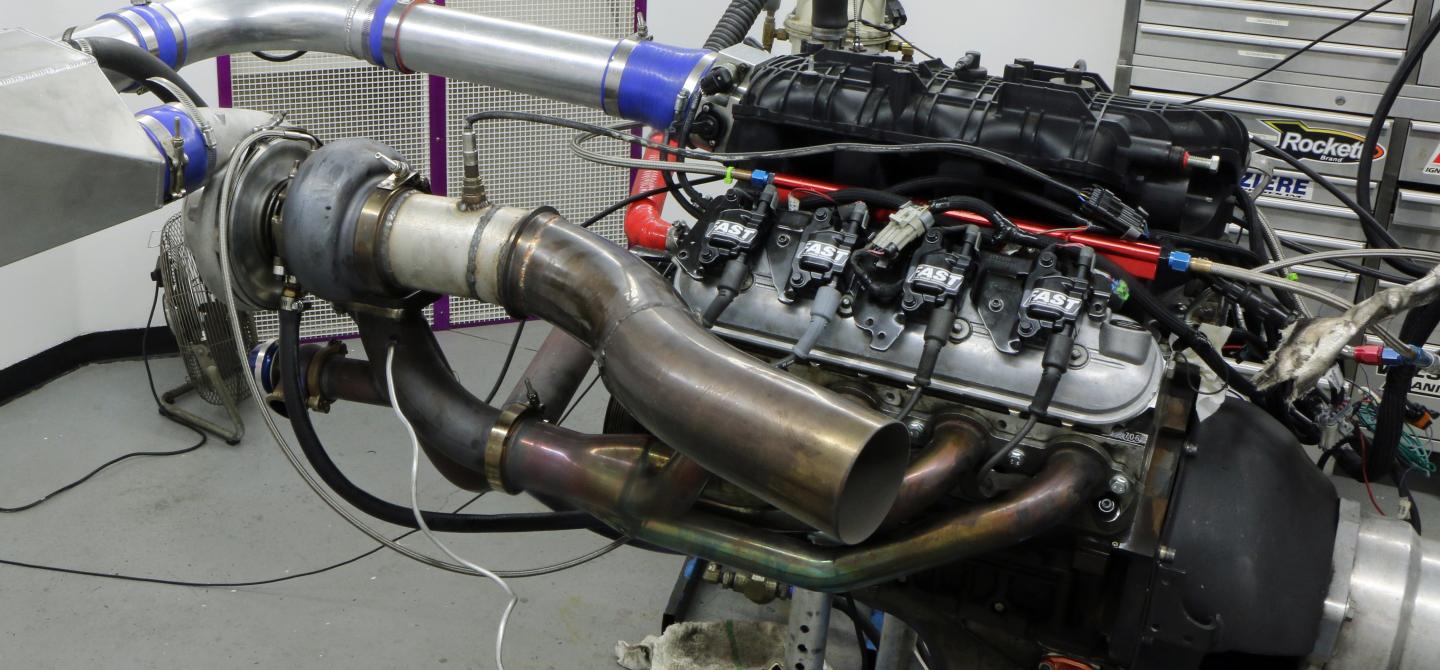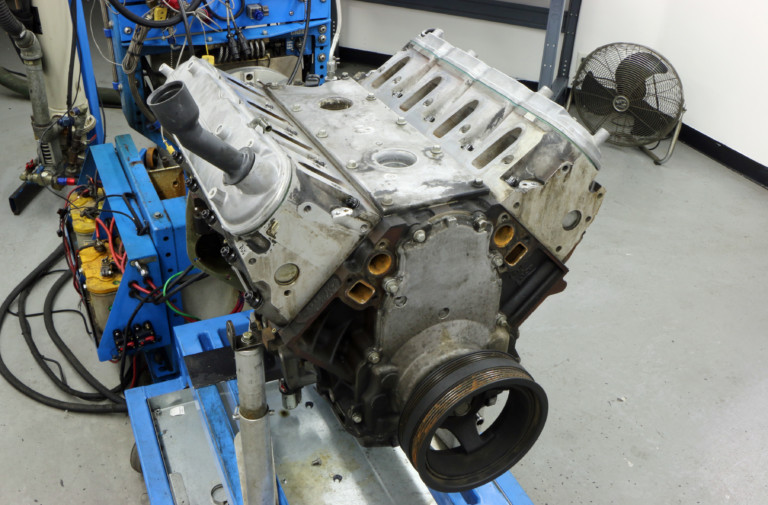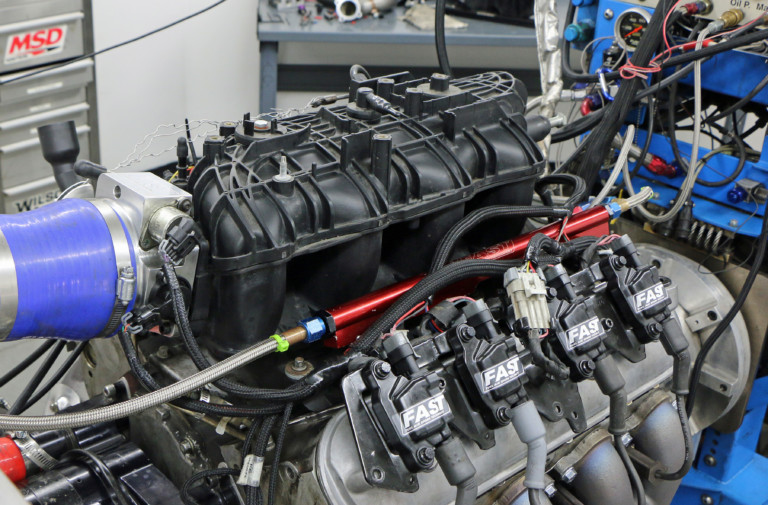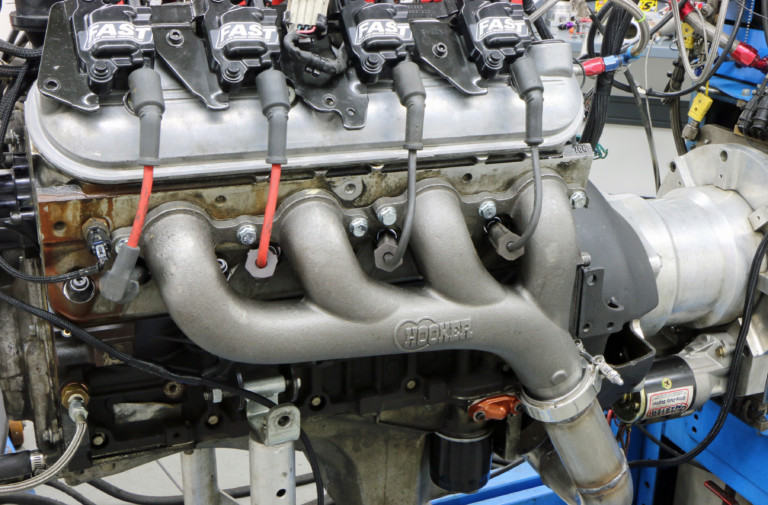If it seems like we beat the LS drum to death, there is a good reason. As a replacement for the original (and ultra-successful) small-block Chevy, the LS had some pretty big shoes to fill. History will show that despite the legendary status, the original small-block can’t hold a candle to the modern mouse. The LS is better in every way, offering more power, improved fuel economy, and reduced emissions.
No longer the new kid in town, the LS has now been replaced by the direct-injected LT engine family. Though an evolutionary step up, even the LT can’t compete with the older LS in this author’s opinion. The LS is still the biggest thing going in the automotive industry. Sure, the newer stuff offers plenty of power, a broader torque curve, and improvements in fuel mileage, but that only applies to the guys who can afford a brand-new vehicle.
What about all the rest of us regular Joes who run on basically beer money? You are not going to find a complete LT1 motor lounging in the wrecking yard for a couple-hundred bucks, nor will you be able to swap it into almost any vehicle imaginable with readily available kits. The LS continues to dominate the market and will do so until the yards empty of all those wonderful potential race motors.
The test engine was a typical junkyard 5.3L, complete with a stock long-block, including factory 706 heads. The heads were treated to a valvespring upgrade in anticipation of wilder cam timing and secured with ARP head studs. LJMS supplied one of its Stage-2 turbo cams for our manifold test. The dedicated turbo grind offered a .605/.598 lift split, a 226/231 duration split and 113 LSA. We also upgraded the pushrods on our turbo motor, from stock to hardened Trend units measuring 7.400 inches. The LM7 originally came with an early truck manifold, but we upgraded it to a TBSS manifold and matching 92-mm FAST throttle body. Note also the FAST fuel rails, 89-pound injectors, and ignition coils.
Boosting Made Easy
The LS certainly has sheer numbers and availability going for it, but let’s now toss boost into the equation. Unlike the original small-block Chevy, the hot set up for an LS owner looking to make serious power is to apply a little positive pressure to the intake tract. The advent of affordable offshore turbos coincided with the popularity-boom of the LS. The combination of the two has produced amazing results.
One only needs to look at the ability to exceed 1,540 horsepower or running seven-second e.t.s with the stock bottom-end to appreciate the potential. For those just joining the program, 500-horsepower street-cars are so five minutes ago! 1,000 horsepower is the new black but fear not. 1,000 horsepower is not some far-off pipe dream.
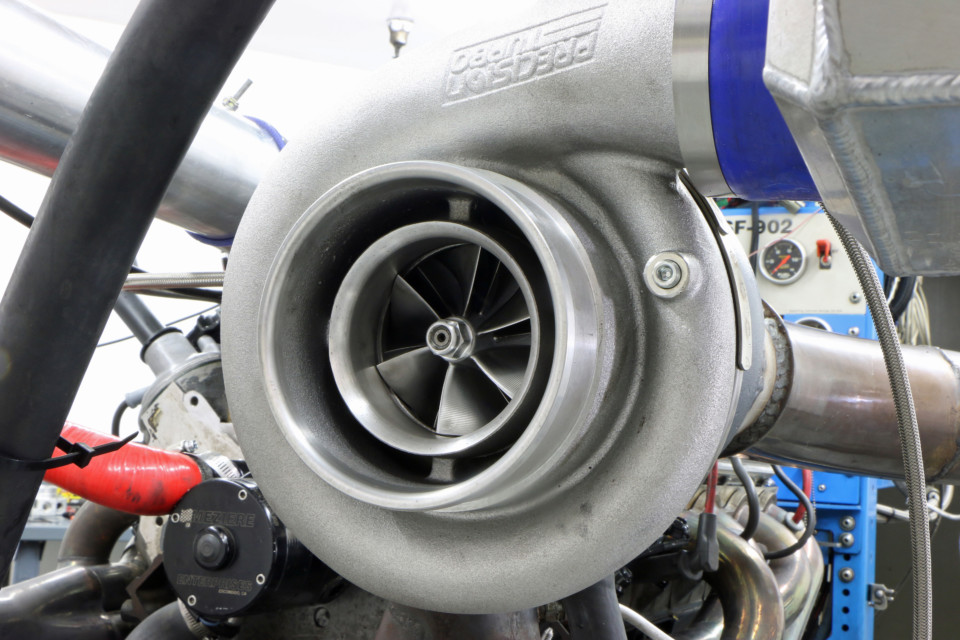
More than a tad overkill for our sub-800-horsepower 5.3L, this billet-wheel 7675 turbocharger from Precision was used for the test. Despite being capable of supporting over 1,100 hp, the PTE turbo worked well at this reduced power level.
The recipe for four-digit power is simple: Start with one wrecking-yard 5.3L, add a cam and valvesprings, then add the required boost. The details are a little more complex, but that is basically it. The popularity of turbo LS engines means there are a great many routes to boosted performance, but so too does it mean there are a great many questions. Luckily for turbo LS enthusiasts, we have answers!
Given the popularity of the turbo LS market, it is only natural that many aftermarket companies jumped in to service the needs of the LS enthusiasts. One company that went big into the market is Holley, offering all manner of components, from simple valley covers to complete engine swap kits.

Keeping things cool on the 11-psi turbo motor was this air-to-water intercooler from Procharger. The cooler was fed 85-degree dyno water and, like the PTE turbo, was capable of supporting considerably more power than our 5.3L was pumping out.
Factory-Quality Aftermarket Manifolds
Included in Holley’s offerings are a pair of cast-steel exhaust manifolds from the Hooker Headers line, designed to allow installation of a single turbo on an LS application. The Hooker manifolds have a lot going for them, including strength, ease of installation, and fitment.
Toss in solid heat retention, great plug access, and adaptability to a variety of different chassis, and you can understand their popularity. The hefty, cast-iron manifolds are considerably stronger than their stainless tubular counterparts, and the cast material and wall-thickness maximize heat transfer to the turbo.
Naturally, the manifolds are as easy to install as factory components and offer exceptional fitment and access for things like plugs and wires. This is in sharp contrast to the tubular turbo headers that limit plug access and require (at a minimum) custom wires. Burned plug wires are also not uncommon with tubular turbo headers.
The Hooker manifolds are built from high silicon-moly ductile iron. The weight alone tells you the Hooker manifolds were designed with strength and longevity in mind. The same cannot be said of the typical, offshore-manufactured tubular manifolds. Note the merge in the passenger-side manifold (right). The passenger-side manifold features a 3.0-inch V-band flange for ease of installation and a leak-free seal.
The Hooker manifolds are designed to work with a cross-under tube to channel the exhaust from the driver’s side to the merge in the passenger-side manifold. The channeled exhaust then flows through a 3.0-inch V-band exit.
As much as we like the Hooker turbo manifolds, we couldn’t help but wonder about the exhaust flow offered by the merged-manifold design. Given the packaging issues often associated with swapping a turbo LS into a tight engine bay, the design is a compromise between fitment and flow. We wanted to see just how well this street turbo system works compared to a more race-oriented setup.
The fitment of the Hooker manifolds is solid. They allow plenty of access to the plugs and plug wires. Unlike the tubular manifolds, there was no need for custom wires or concern about burning wires once installed. (Right) Exhaust from the driver’s side manifold was fed to the passenger side merge via a cross-under tube. We designed our own for the dyno, but Hooker offers a number of 2.5-inch cross-under tubes for a variety of chassis applications.
Putting the Manifolds to the Test
To gauge the differences in power, we set up a test starting with a stock 5.3L LM7. We increased the ring gap to .030 inch on the stock short-block, then added ARP head studs and fresh .041-inch-thick Fel-Pro MLS head gaskets. Additional components included COMP Cams 26918 valvesprings, a Lil John Motorsports Solutions Stage-2 turbo cam (.605/.598 lift, 226/231 duration at .050, 113 LSA) and a TrailBlazer SS intake manifold.
Also used in the setup were a set of FAST 89lb/hr injectors, a FAST 92-mm throttle body, and Holley HP engine management system. Feeding boost to the 5.3L was a single Precision 7675 turbocharger. A ProCharger air-to-water intercooler kept the IATs in check, and a single Turbosmart Hypergate45 wastegate managed boost levels.
(Left) The race system consisted of these tubular turbo headers. The stainless construction was nice, but the fitment and plug access left something to be desired. The turbo manifolds fed a dedicated 3-inch Y-pipe equipped with a T4 turbo flange and dual wastegates. (Right) To ensure adequate post-turbo exhaust flow, we installed this 4.0-inch race exhaust on our PTE turbo. Note the V-band flange on the exhaust and turbine housing as well as the bungs for the oxygen sensor.
To demonstrate a change in power, we needed something to compare the Hooker manifolds against. This was not a problem, as we had a race system on hand with plenty of dyno time. The race system featured tubular headers from DNA Motoring equipped with 3.0-inch V-band flanges. For turbo use, the headers were reversed to feed forward, then connected to a custom, 3.0-inch Y-pipe fitted with a T4 turbo flange.
In addition to the flange, the Y-pipe also featured provisions for a pair of Turbosmart wastegates and a fitting to allow measurement of pre-turbo exhaust backpressure. We drilled and tapped the 90-degree turbo flange used on the Hooker system to monitor backpressure as well. Now, all we had to do was run the two systems at the same boost level and measure any difference in back pressure and power.

Controlling the all-important fueling and timing needs was a Holley HP engine management system. We kept the air/fuel ratio at 11.7:1 and the timing at a peak of 22 degrees.
If only it were that easy. You see, the operation of the wastegate is a function of more than just boost pressure. Exhaust back pressure plays a part in the opening of the gate as well. Exhaust pressure acts on the face of the valve, while boost pressure acts on the diaphragm. We also have dual wastegates on one system and a single gate on the other.
That means there was no way (short of possibly an electronic wastegate) to match the boost curves of these two combinations. Instead, we were forced to match boost and backpressure at a specific engine speed.
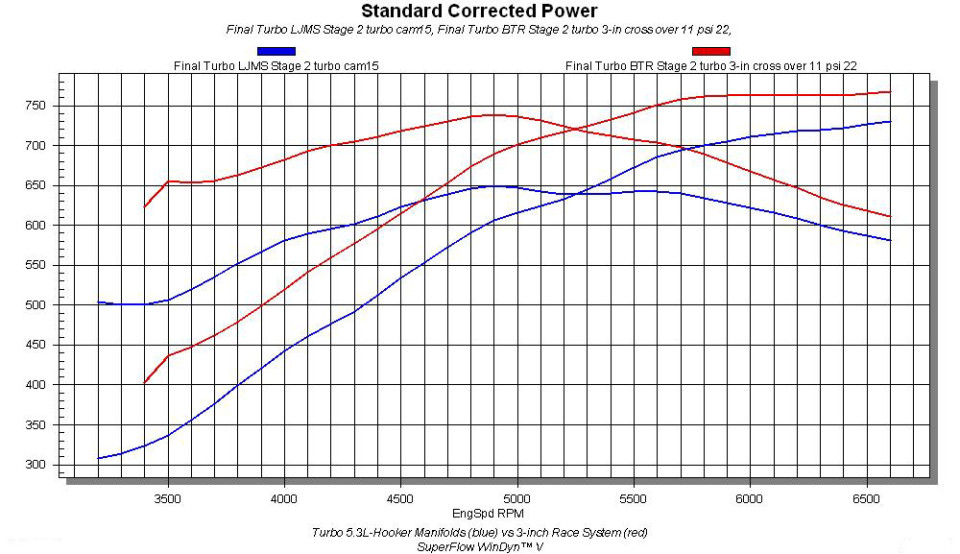
Run with the Hooker turbo manifolds, the combo produced 730 hp at 6,600 rpm and 649 lb-ft of torque at 4,900 rpm. Controlled by a manual controller, the single wastegate and Hooker manifolds produced a rising boost curve that peaked at 11.3 psi at 6,600 rpm. Run with the 3.0-inch race manifold set up, the engine produced peak numbers of 768 hp at 6,600 rpm and 739 lb-ft of torque, but the peak torque values were more a function of the extra boost offered in the middle of the curve (see boost graph).
First up on the dyno was the Hooker system. The Turbosmart wastegate was combined with the manual controller to provide a maximum boost pressure of 11.3 psi. Run at this boost level with 21 degrees of total timing (on race gas) and an air/fuel ratio of 11.8:1, the turbo 5.3L produced 729.8 hp at 6,600 rpm and 649.3 lb-ft of torque at 4,900 rpm.
The boost pressure started at 7.7 psi and rose to a peak of 11.3 psi. The exhaust pressure registered in the system began at 6.2 psi, then rose to a maximum of 21.2 psi, meaning the backpressure was almost twice as high as boost pressure (21.2 psi vs. 11.3 psi).
For the next test, we reconfigured the exhaust with the 3.0-inch race system. Run with the new race set up, the power output of the turbo 5.3L rose to 768.1 hp at 6,600 rpm and 739.4 lb-ft at 4,900 rpm. The peak torque value was significantly higher because of the significant change in the boost curve, due to the different wastegate setups.
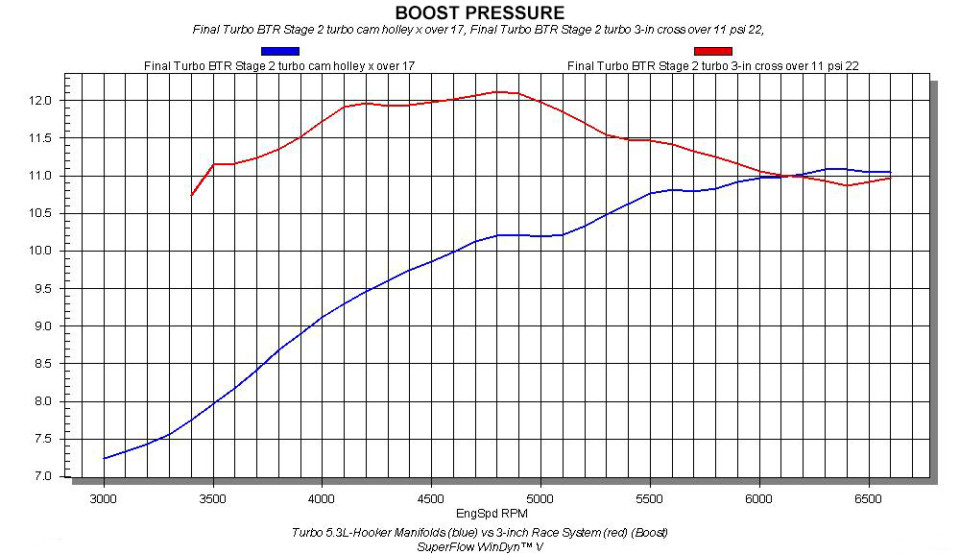
The boost pressure curves help explain the sizable difference in power production between the two systems. The change in the boost curves was a function of two major elements — changing from one to two wastegates and the increase in exhaust backpressure. The amount of backpressure works with the boost pressure to open the gate. Using a manual controller, we adjusted the boost pressure on the race manifolds to match the 11 psi reading we got with the Hooker manifolds at 6,100 rpm. Note the crossover of the two boost curves at this point.
Looking at the difference in power at a point where the two systems had identical boost levels, air/fuel ratios, and timing gives us a better look at the real story. Measured at 6,100 rpm, the power difference between the two systems was 47 horsepower.No doubt caused by the more than 6-psi difference in exhaust backpressure (14.2 psi for the tubular headers vs. 20.3 psi for the cast manifolds).
Obviously, there are power gains to be had from the freer-flowing tubular exhaust manifolds. But given the hassles associated with running the tubular pieces, as well as the durability of a cast manifold, we’d opt for the Hooker manifolds on almost any street application.

The exhaust backpressure curves tell the tale of this test. The Hooker manifolds offered decidedly more backpressure than the race-oriented tubular manifolds. The difference in pressure between the two systems reached 7 psi (14 psi vs. 21 psi), meaning the boost-to-backpressure ratio reached nearly 2:1 (11 psi, boost and 21 psi, backpressure) with the Hoooker manifolds. The reduction in backpressure resulted in extra power in the race setup, but the extra power comes with potential problems. The ideal situation would be a system that fits and lasts like the Hooker, but offers performance like the race manifolds.


